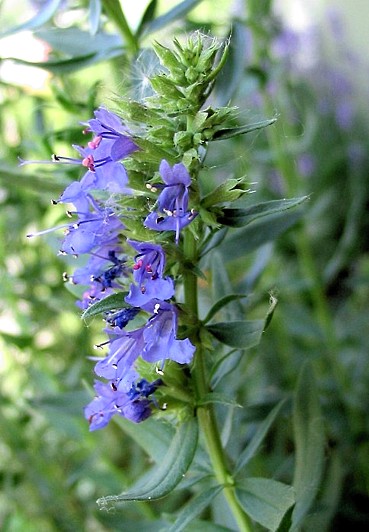Lessico
Issopo
Hyssopus officinalis
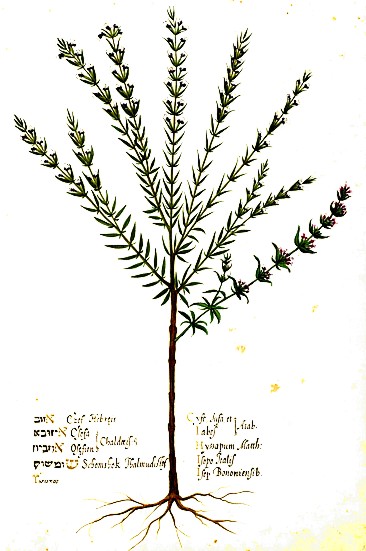
Acquarello![]() di Ulisse Aldrovandi
di Ulisse Aldrovandi
Pianta della famiglia Labiate, originaria dei Paesi del bacino mediterraneo, che cresce sporadicamente anche in Italia, nelle regioni centro-settentrionali.
È un suffrutice eretto, cespuglioso, alto fino a 60 cm, con foglie sessili lanceolate e fiori azzurri o rosei. Le foglie e i fiori contengono un olio essenziale usato in medicina come aromatizzante.
Salmi 51 [1] Al maestro del coro. Salmo. Di Davide. [2] Quando venne da lui il profeta Natan dopo che aveva peccato con Betsabea. [3] Pietà di me, o Dio, secondo la tua misericordia; nella tua grande bontà cancella il mio peccato. [4] Lavami da tutte le mie colpe, mondami dal mio peccato. [5] Riconosco la mia colpa, il mio peccato mi sta sempre dinanzi. [6] Contro di te, contro te solo ho peccato, quello che è male ai tuoi occhi, io l'ho fatto; perciò sei giusto quando parli, retto nel tuo giudizio. [7] Ecco, nella colpa sono stato generato, nel peccato mi ha concepito mia madre. [8] Ma tu vuoi la sincerità del cuore e nell'intimo m'insegni la sapienza. [9] Purificami con issopo e sarò mondo; lavami e sarò più bianco della neve.
Vangelo di Giovanni: 28 Μετὰ τοῦτο εἰδὼς ὁ Ἰησοῦς ὅτι ἤδη πάντα τετέλεσται, ἵνα τελειωθῇ ἡ γραφή, λέγει, Διψῶ. 29 σκεῦος ἔκειτο ὄξους μεστόν· σπόγγον οὖν μεστὸν τοῦ ὄξους ὑσσώπῳ περιθέντες προσήνεγκαν αὐτοῦ τῷ στόματι.
28 postea sciens Iesus quia iam omnia consummata sunt ut consummaretur scriptura dicit sitio 29 vas ergo positum erat aceto plenum illi autem spongiam plenam aceto hysopo circumponentes obtulerunt ori eius
[28] Dopo questo, Gesù, sapendo che ogni cosa era stata ormai compiuta, disse per adempiere la Scrittura: "Ho sete". [29] Vi era lì un vaso pieno d'aceto; posero perciò una spugna imbevuta di aceto in cima a una canna e gliela accostarono alla bocca.
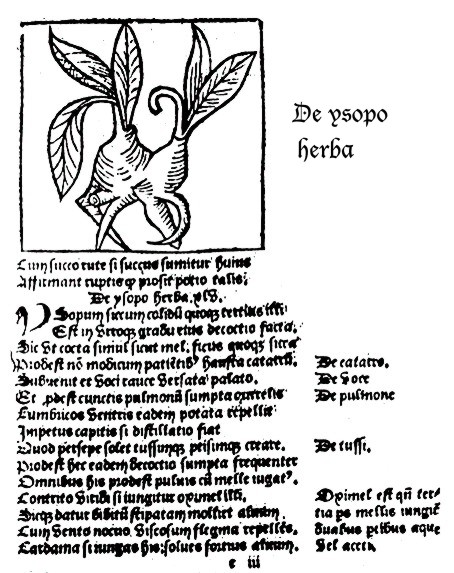
De
viribus herbarum di Floridus Macer![]()
forse la prima versione in stampa del 1477
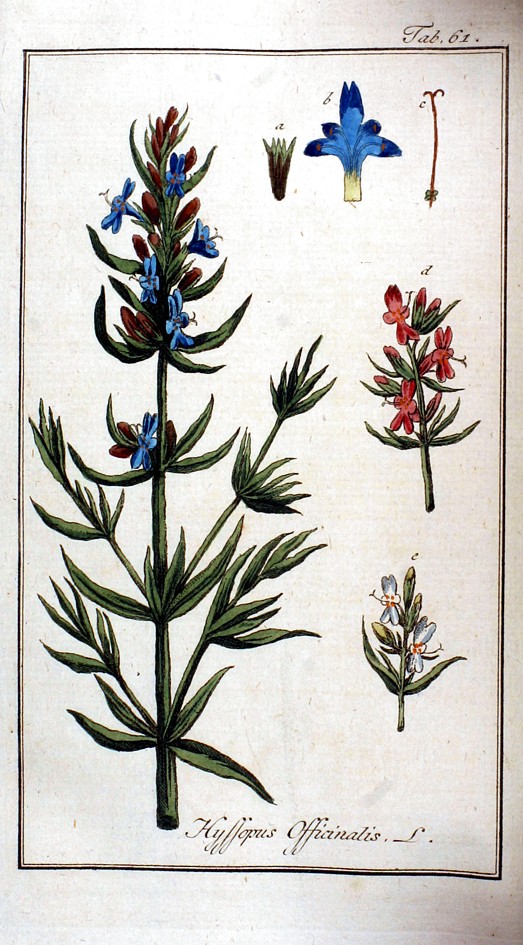
L'Hysope ou hysope officinale est un arbrisseau vivace de la famille des Lamiacées, que l'on trouve dans les environnement de type garrigue dans les régions méditerranéennes. Ses fleurs, qui peuvent être violettes, bleues, blanches ou rouges, sont groupées en épis. Son nom scientifique est Hyssopus officinalis L., de la famille des Lamiacées (Labiées). C'était l'herbe sacrée des Hébreux.
Espèce originaire d'Europe méridionale, Afrique du Nord, et Asie occidentale (Proche-Orient, Caucase), elle a été naturalisée par la culture dans toute l'Europe et en Amérique du Nord.
L'hysope trouvait sa place dans les jardins des simples, jardins de curés et autres jardins médiévaux. Elle préfère les emplacements ensoleillés dans une terre plutôt sèche et bien drainée.
La multiplication peut se faire par semis au printemps en pépinière, les jeunes plants étant mis en place à l'automne, ou bien par division de vieilles touffes au printemps. Elle appartient à la liste de plantes qui se prêtent bien aussi au bouturage.
La récolte peut intervenir quelques mois après la plantation. On prélève les tiges feuillées avant floraison. Pour obtenir des feuilles tendres, éliminer au fur et à mesure les tiges florales.
L'hysope est utilisée dans les jardins d'ornement comme plante de rocaille. C'est aussi une plante mellifère.
L'hysope
est une plante potagère en tant que plante condimentaire. Ses feuilles, fraîches
ou séchées, sont utilisées, finement hachées, pour aromatiser les crudités
et salades, les farces pour le porc, l'oie ou le canard, mais aussi dans les
sauces et les soupes. Ses fleurs relèvent agréablement le goût des salades
et des légumes.
Elle entre aussi dans la composition de certaines liqueurs, du pastis, de
l'eau de mélisse, de l 'absinthe suisse. C'est l'un des éléments essentiels
de l'élixir de la Grande-Chartreuse, de la bénédictine.L'hysope a pu aussi
servir d'agent aromatisant lors du brassage de la bière.
L'huile essentielle d'hysope est interdite en vente libre car elle est neurotoxique et abortive. Cependant, on retrouve l'huile d'Hysope dans la liste d'additifs dans les cigarettes.
L'hysope est une plante médicinale. Toute les parties de la plante sont utilisées pour différentes indications thérapeutiques: antiseptique, stimulante, stomachique et expectorante.
Utilisation
traditionnelle:
pour stimuler la digestion (aromate),
pour aider à l'évacuation des gaz intestinaux (carminatif),
comme tonique pour fortifier et soulager les muqueuses des voies respiratoires
et des voies gastro-intestinales,
comme expectorant pour soulager la toux et autres affections des poumons,
pour fortifier le système respiratoire (pectoral),
pour réduire la fièvre (antipyrétique),
pour induire la sudation (diaphorétique).
L'hysope était le bois avec lequel on donna à boire de la posca à Jésus lors de sa crucifixion. Après quoi, sachant que désormais tout était achevé pour que l'Écriture fût parfaitement accomplie, Jésus dit: "J'ai soif." Un vase était là, rempli de vinaigre. On mit autour d'une branche d'hysope une éponge imbibée de vinaigre et on l'approcha de sa bouche. (Jean 19:28-29).
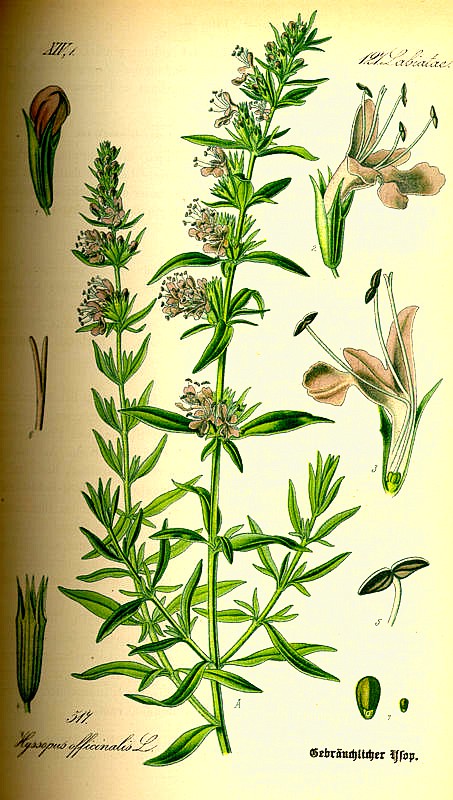
Hyssop (Hyssopus) is a genus of about 10-12 species of herbaceous or semi-woody plants in the family Lamiaceae, native from the Mediterranean east to central Asia. They are aromatic, with erect branched stems up to 60 cm long covered with fine hairs at the tips. The leaves are narrow oblong, 2-5 cm long. The small blue flowers are borne on the upper part of the branches during summer. By far the best-known species is the Herb Hyssop (Hyssopus officinalis), widely cultivated outside its native area in the Mediterranean.
Species
Hyssopus ambiguus (Trautv.) Iljin
Hyssopus cretaceus Dubjan.
Hyssopus cuspidatus Boriss.
Hyssopus ferganensis Boriss.
Hyssopus latilabiatus C.Y.Wu & H.W.Li
Hyssopus lophanthoides Buch.-Ham. ex D.Don
Hyssopus macranthus Boriss.
Hyssopus ocymifolius Lam.
Hyssopus officinalis L.
Hyssopus seravschanicus (Dub.) Pazij
Hyssopus tianschanicus Boriss.
The name 'hyssop' can be traced back almost unchanged through the Greek hýssøpos. In the New Testament, a sponge soaked in sour wine or vinegar was stuck on a branch of hyssop and offered to Jesus of Nazareth on the cross just before he died (John 19:29). Both Matthew and Mark mention the occasion but refer to the plant using the general term kálamos, which is translated as "reed" or "stick". Traditionally, hyssop has been used as a strewing herb, and many of its historical healing properties that had been previously dismissed as are once again being acknowledged.
The seeds are sown in spring and the seedlings planted out 40-50 cm apart. Hyssop can also be propagated from heel cuttings or root division in spring or autumn. Hyssop should be grown in full sun on well drained soil, and will benefit from occasional clipping. It is short-lived, and the plants will need to be replaced every few years. Ideal for use as a low hedge or border within the herb garden. Hyssop is used as a food plant by the larvae of some Lepidoptera species including Cabbage Moth.
Hyssop leaves have a slightly bitter minty flavour and can be added to soups, salads or meats, although should be used sparingly as the flavour is very strong. Hyssop also has medicinal properties which are listed as including expectorant, carminative, relaxes peripheral blood vessels, promotes sweating, anti-inflammatory, anti-catarrhal, antispasmodic. Its active constituents are volatile oil, flavonoids, tannins and bitter substance (marrubin).
A strong tea made from the leaves and flowering tops is used in lung, nose and throat congestion and catarrhal complaints, and externally it can be applied to bruises, to reduce the swelling and discolouration. An old English country remedy for cuts and wounds suffered while working in the fields was to apply a poultice of bruised hyssop leaves and sugar in order to reduce the risk of tetanus infection. An essential oil made from hyssop increases alertness and is a gently relaxing nerve tonic suitable for treating nervous exhaustion, overwork, anxiety and depression. The Herb Society's "Complete Medicinal Herbal" cautions however that "the essential oil contains the ketone pino-camphone which in high doses can cause convulsions. Do not take more than the recommended dose."
Hyssop also has uses in the garden, it is said to be a good companion plant to cabbage, partly because it will lure away the Cabbage White butterfly, and according to Dorothy Hall (The Book Of Herbs, Pan 1972) has also "been found to improve the yield from grapevines if planted along the rows, particularly if the terrain is rocky or sandy, and the soil is not as easy to work as it might be". However hyssop is said to be antagonistic to radishes, and they should not be grown nearby. Hyssop also attracts bees, hoverflies and butterflies, thus has a place in the wild garden as well as being useful in controlling pests and encouraging pollination without the use of unnatural methods. Hyssop is also used as an ingredient in eau de Cologne, and in the liqueur Chartreuse.
Hyssop leaves can be preserved by drying. They should be harvested on a dry day at the peak of their maturity and the concentration of active ingredients is highest. They should be dried quickly, away from bright sunlight in order to preserve their aromatic ingredients and prevent oxidation of other chemicals. Good air circulation is required, such as an airing cupboard with the door left open, or a sunny room, aiming for a temperature of 20-32°C. Hyssop leaves should dry out in about six days, any longer and they will begin to discolour and lose their flavour. The dried leaves are stored in clean, dry, labelled airtight containers, and will keep for 12-18 months.
